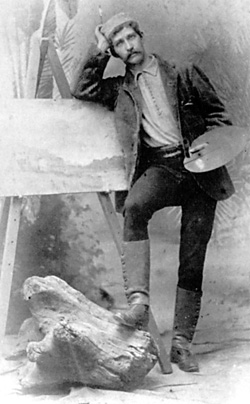Baum and the Bad Guys
 One of the highlights of last year's International Wizard of Oz Club convention in Fayetteville, New York, was a concert performance of L. Frank Baum's first successful play, The Maid of Arran. It debuted in 1882, eighteen years before Baum published The Wonderful Wizard of Oz. The performers were an impressive collection of singers and VIPs from greater Fayetteville, and everyone in the hall had a grand time.
One of the highlights of last year's International Wizard of Oz Club convention in Fayetteville, New York, was a concert performance of L. Frank Baum's first successful play, The Maid of Arran. It debuted in 1882, eighteen years before Baum published The Wonderful Wizard of Oz. The performers were an impressive collection of singers and VIPs from greater Fayetteville, and everyone in the hall had a grand time.
Baum based The Maid of Arran on William Black's novel A Princess of Thule, so he wasn't responsible for the whole story, but he added elements that struck me as particularly Baumian. (I should acknowledge that I'm basing these comments on my memory of a show boiled down from Baum's longer script. I may not therefore get every detail right. But back to the show.)
At the center of the play is Shiela, the young, pretty, and rural but acceptably upper-class Irish maiden of the title. She's wooed by two men, who also happen to be friends of each other:
The artist becomes infatuated with this island lass and, despite his friend's reminder about his habits, marries her and brings her to London. There Holcomb discovers that his new bride is far from urbane. He tires of her, and Shiela returns in tears to Arran.
So with whom do you want Shiela to end up? Before placing your bets, consider that young Baum wrote the part of Hugh Holcomb for himself. That's him above, looking ever so artistic.
In the play, Shiela's departure shocks Holcomb into recognizing how much she means to him, and he resolves to change. He decides the best way to do this is to enlist in the Royal Navy, and ends up on Ingram's ship. Ingram, revealing a side of his personality that he's hidden completely so far, claps Holcomb in the brig and vows to break him. The artist must escape in order to make his way back to Arran, his bride, and a happy ending.
So the play's hero is deeply flawed, not an easy man to root for. The villain isn't immediately apparent, and perhaps wouldn't even become villainous if he hadn't seen the woman he loves go off with a deeply flawed young man.
(Hungry Tiger Press's website features some images from The Maid of Arran and a MIDI download of Holcomb's song "A Rollicking Irish Boy.")
Another highlight of the convention was a screening of what remains of The Last Egyptian, a silent movie that Baum's Oz Film Manufacturing Company made in 1914 as a desperate attempt for adult audiences, based on a novel he'd published anonymously. (Again, I'm basing this summary on my memory of an incomplete presentation.) It too has several major male characters:
So who's the hero of The Last Egyptian? Who's the villain? Who wins the hand of Lord Roane's granddaughter Aneth? Whose swift action saves the day?
Highlight this space for the answer: Lord Roane and Viscount Consinor are villains. But Kara is also a villain after a promising start as an antihero. Winston wins Aneth, but the person who makes everything work out in the end is Tadros the dragoman.
As the Yellowback Library has said of Baum, “At his best, his novels are tinged with a certain amount of cynicism--you weren't always sure at first who the good guys were.” At his best, Baum wrote about characters' points of views and values with equal investment in each one. At his worst, he played into the prejudices and expectations of his audiences. These two convention presentations showed those traits of Baum's storytelling style colliding, producing plots that, if they weren't entirely understandable or satisfying, at least kept me guessing.


4 comments:
That is great that the Club put on both of those things. Some day I WILL make it to one of the conventions. Do you know how much of "The Last Egyptian" they showed? All that I have seen of it is about a ten second clip in an art film that featured deteriorating 35mm nitrate movie film ("Decasia": http://www.imdb.com/title/tt0303325/).
It was actually a local group that performed The Maid of Arran, though the Oz Club's presence no doubt provided an impetus and an audience.
An Oz Club member paid for the showing of The Last Egyptian, as I recall. We saw as much of the Metropolitan Museum of Art's print as survives—far more than 10 seconds, but still not a complete story, and with some damaged sections.
David Moyer, an expert on the Baums' trip to Egypt and its literary and cinematic fruits, was there to explain the story and fill in the gaps.
What remains of The Last Egyptian runs about 30 minutes.
And yet it can seem so much longer!
I neglected to mention that an Oz movie expert named Scott Hutchins spotted the The Last Egyptian clip in Decasia and set in motion the inquiry that led to the recognition and preservation of what remains of the movie. So that was a significant ten seconds.
Post a Comment